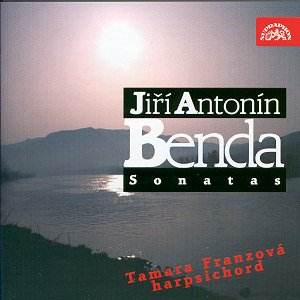Comparison
recording:
J.
C. Mann, 6 harpsichord Sonatas, R. E. Simpson, harpsichord Initium
CD A001/2
AVAILABILITY
Initium
CDs are available from rsimpson@velocitus.net.
Benda
is one of those Czech composers who were featured on a series
of sumptuously illustrated Supraphon LP recordings with many photographs
and what are probably fascinating and informative texts ó what
a pity I donít read a word of Czech. The music was always very
interesting and very much of its period, but out of all that listening
no single work ever caught my attention enough to actually become
familiar to me. Here with notes in English I can at last learn
something about a composer I already know.
Benda
was born in N-E Bohemia, and his father was a weaver and folk
musician. Benda got a good local education then emigrated with
his family in 1742 to Berlin where he joined his older brother
Frantisek in the violin section of the Prussian court opera orchestra.
In 1750 he became Kapellmeister in Gotha where, in addition to
the usual composing of all kinds of church and secular music for
all combinations of instruments, he also achieved distinction
as a writer of melodramas, two of which were in Mozartís personal
library. He failed to obtain an appointment in Vienna in 1778,
and retired to study and compose in the town of Köstritz
in Saxony.
These
sonatas resemble the harpsichord sonatas of Johann Christoph Mann
(1726 - 1782). Note that the two composers were born within two
years of each other. Both were active in the same general area
of Europe, Mann a native Austrian based in Vienna but spending
much time in Bohemia. Both wrote clearly in a North European pre-classical
style (Mann uses a Scottish folk song in his fourth sonata) in
three movements, both wrote both for harpsichord as well as fortepiano,
and both men in their music set out to entertain, writing in a
variety of forms and utilising songs, dances, and even operatic
style settings. Benda is rather serious; Mann has more fun with
his music. Although Benda was a friend of C.P.E. Bach, his music
resembles that of the older man only slightly. C.P.E. Bachís keyboard
music tended to be stiff, conservative, and somewhat ungracious,
whereas both Benda and Mann wrote very floridly and eloquently
with bold harmonic colour. The interesting fact is that the pre-Classical
period was more experimental harmonically than the Classical period
and it is not until Chopin and Schumann that you see bolder harmonies.
And
both composers are not well known to modern audiences, yet hearing
their music will teach you quite a bit about the evolution of
German and Viennese Classical keyboard style. Some of these movements
are almost pure Bach, some almost pure Mozart, and thereís just
a hint of Beethoven here and there.
J.
C. Mann used to be frequently confused with G. M. Monn (1717 -
1750), but Simpsonís research has established their separate identities,
although they may have been brothers.
Ms.
Franzová plays a full size two manual instrument with a
clear, sweet tone and little tonal difference between the manuals.
Simpson uses an electronically sampled MIDI two manual harpsichord
for his Mann recordings, and both use equal temperament tuning
which most people will probably feel is appropriate, although
I take exception to that and am convinced that unequal temperament
was very much in use on keyboard instruments even after 1800.
Both Franzová and Simpson use excellent judgement in ornamentationóneither
too much nor too little. Ms. Franzová receives excellent
well balanced recording that is close but not too much so, with
just the right amount of live acoustic to allow the sound to breathe,
but the lines remain perfectly clear. Simpsonís recorded sound
is very close and dynamic, and he makes judicious use of the coupled
16 foot rank.
Ms.
Franzová studied harpsichord with Christiane Jaccottet
and musicology in Switzerland and Germany, attending master classes
given by Hogwood, Koopman, and Leonhardt, among others. Simpson
studied with Paul Nettl at Indiana University, played oboe in
the orchestra under Wolfgang Stressemann, and then studied musicology
at University of Vienna with Schenk.
Paul Shoemaker
